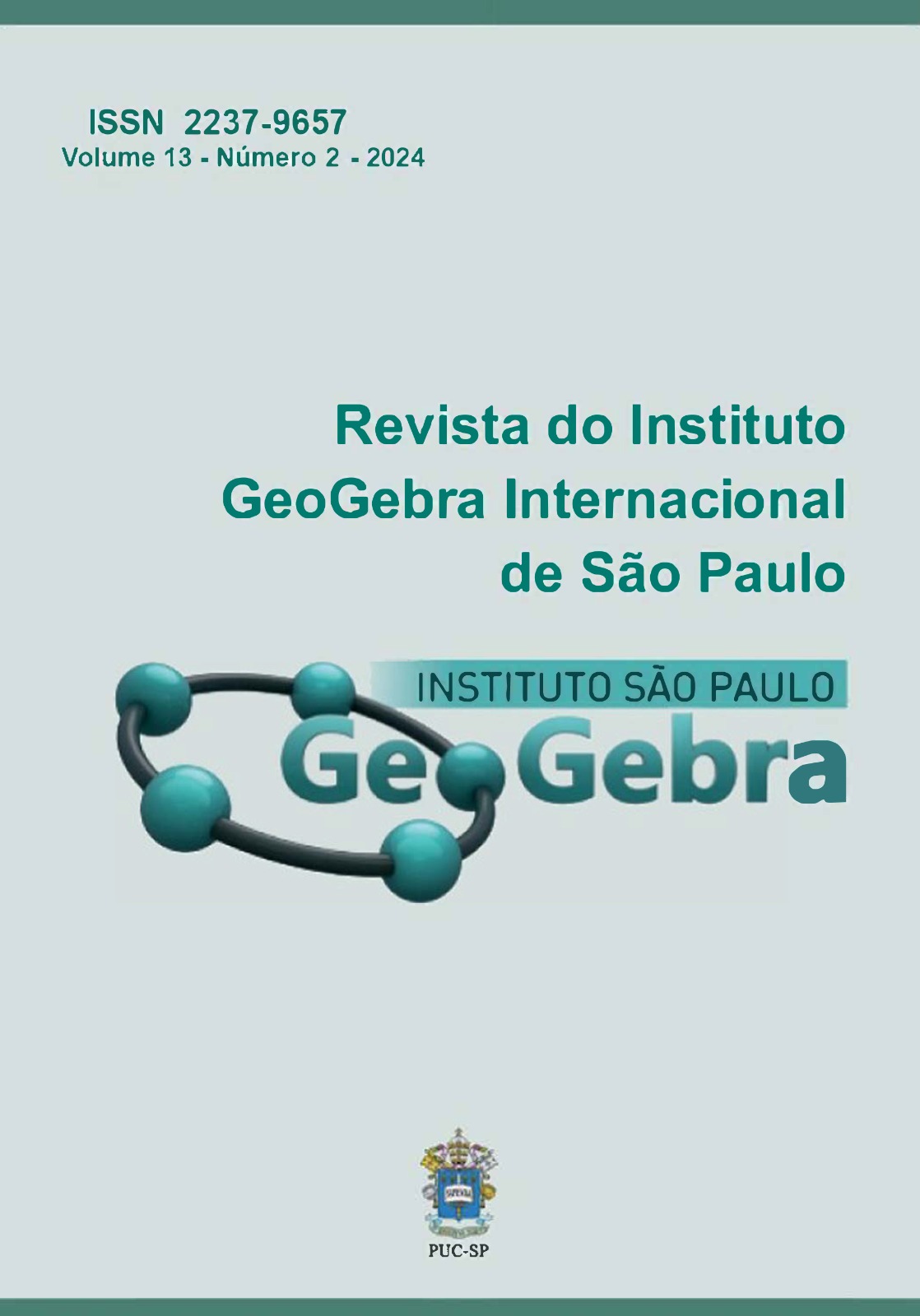A geometric approach to relations between Fibonacci and Leonardo numbers with the contribution of GeoGebra.
DOI:
https://doi.org/10.23925/2237-9657.2024.v13i2p032-047Keywords:
geometric representation, Fibonacci sequence, Leonardo sequence, GeoGebraAbstract
The study of numerical sequences is well covered in the context of Pure Mathematics, in particular the Fibonacci sequence that proves from the problem of infinite rabbits and is addressed in several areas. And, also, from this sequence is to present other sequences, for example: the Leonardo sequence, this sequence has a similarity with the Fibonacci sequence because it requested similar recurrence and its numbers present a possible relationship between them. Thus, this article deals with a tolerant approach on the relationships of Fibonacci and Leonardo numbers using the GeoGebra software. In addition, the definitions and properties that make the relationship between these numbers were tolerated. As well as a geometric construction from graphs, through the studied sequences, creating identities based on triangles formed from the connection between the numbers.
References
ALP, Y.; KOÇER, E. G. Some properties of Leonardo numbers. Konuralp J. Math, v. 9, n. 1, p. 183-189, 2021.
ALVES, F. R. V.; CATARINO, P. M. M. C. A classe dos polinômios bivariados de Fibonacci (PBF): elementos recentes sobre a evolução de um modelo. Revista Thema, v. 14, n. 1, p. 112-136, 2017.
ALVES, F. R. V. Fórmula de de moivre, ou de binet ou de lamé: demonstrações e generalidades sobre a sequência generalizada de Fibonacci - SGF. Revista Brasileira de História da Matemática, [s. l.], v. 17, n. 33, p. 01–16, 2020.
BARROS, F. E. et al. The construction of figured numbers in GeoGebra software using algebraic properties. The Mathematics Enthusiast, v. 21, n. 1, p. 203-224, 2024.
BOYER, C. B. História da Matemática. 2ª ed. Edgard Blücher, 2006.
CATARINO, P. M. M. C.; BORGES, A. On Leonardo numbers. Acta Mathematica Universitatis Comenianae, v. 89, n. 1, p. 75-86, 2019.
CATARINO, P. M. M. C.; SPREAFICO, E. A Note on Bi-Periodic Leonardo Sequence. Armenian Journal of Mathematics, v. 16, n. 5, p. 1-17, 2024.
DUNLAP, R. A. The golden ratio and Fibonacci numbers. World Scientific, 2003.
GÖKBAS, H. A New Family of Number Sequences: Leonardo-Alwyn Numbers. Armenian Journal of Mathematics, [S. l.], v. 15, n. 6, p. 1–13, 2023.
GOMES, C. A.; OLIVEIRA, O. d. O teorema de Cayley-Hamilton. IME-USP Oswaldo Rio Branco de Oliveira, p. 1–11, 2019.
KOSHY, T. Fibonacci and Lucas Numbers with Applications, Volume 2. John Wiley & Sons, 2001.
PRASAD, K.; MOHANTY, R.; KUMARI, M.; MAHATO, H. Some new families of generalized ?-Leonardo and Gaussian Leonardo Numbers. Communications in Combinatorics and Optimization, v. 9, n. 3, p. 539-553, 2024.
POSAMENTIER, A. S.; LEHMANN, I. The (Fabulous) Fibonacci Numbers. Prometheus Books, 2007.
SHANNON, A. G. A note on generalized Leonardo numbers. Notes on Number Theory and Discrete Mathematics, v. 25, n. 3, p. 97-101, 2019.
MANGUEIRA, M. C. S. Engenharia Didática: Um processo de Hibridização e Hipercomplexificação de sequências lineares recursivas. Dissertação (Mestrado em Ensino de Ciências e Matemática). Instituto Federal de Educação, Ciência e Tecnologia do Ceará, Fortaleza, 2022.
MATHIAS, C. V.; DA SILVA, H. A.; LEIVAS, J. C. P. Provas sem palavras, visualização, animação e GeoGebra. Revista do Instituto GeoGebra Internacional de São Paulo, [S. l.], v. 8, n. 2, p. 62–77, 2019.
ÖZIMAMOĞLU, H. On Leonardo sedenions. Afrika Matematika, v. 34, n. 2, p. 26, 2023.
RAMOS, M. G. O. A Sequência de Fibonacci e o Número de Ouro. Dissertação (Mestrado em Matemática). Universidade Estadual de Santa Cruz, Ilhéus, Brasil, 2013.
SANTOS, M. G. M. D.; SOUSA, R. T. DE; ALVES, F. R. V. Situações Didáticas Profissionais: concepções e obstáculos no ensino de sistemas lineares e o uso do GeoGebra. Revista Internacional de Pesquisa em Educação Matemática, v. 14, n. 1, p. 1-22, 15 abr. 2024.
SOUSA, R. T.; ALVES, F. R. V.; AIRES, A. P. F. Categories of Intuitive Reasoning in the Teaching of Parabolas: A Structured Practice in Didactic Engineering. International Electronic Journal of Mathematics Education, v. 18, n. 4, 2023.
VIEIRA, R. P. M.; ALVES, F. R. V.; CATARINO, P. M. M. C. Relações bidimensionais e identidades da sequência de Leonardo. Revista Sergipana de Matemática e Educação Matemática, v. 4, n. 2, p. 156-173, 2019.
WELLS, D. Prime Numbers: the mysterious figures in the Math. John Wiley and Sons Inc., 2005.
Downloads
Published
How to Cite
Issue
Section
License
Copyright (c) 2024 Revista do Instituto GeoGebra Internacional de São Paulo

This work is licensed under a Creative Commons Attribution 4.0 International License.
Submission, processing, and publication of articles sent to the journal and registration of the DOI at Crossref is free of charge.
Authors retain their copyright and grant the journal the right of first publication of their article, which is simultaneously licensed under a Creative Commons - Attribution 4.0 International license CC BY that allows others to share the article by acknowledging its authorship and initial publication by the journal.
The GeoGebra journal encourages its authors to register their work with information and communication management systems aimed at researchers, such as Academia.edu, Mendeley, ResearchGate, etc.


 10.23925
10.23925
